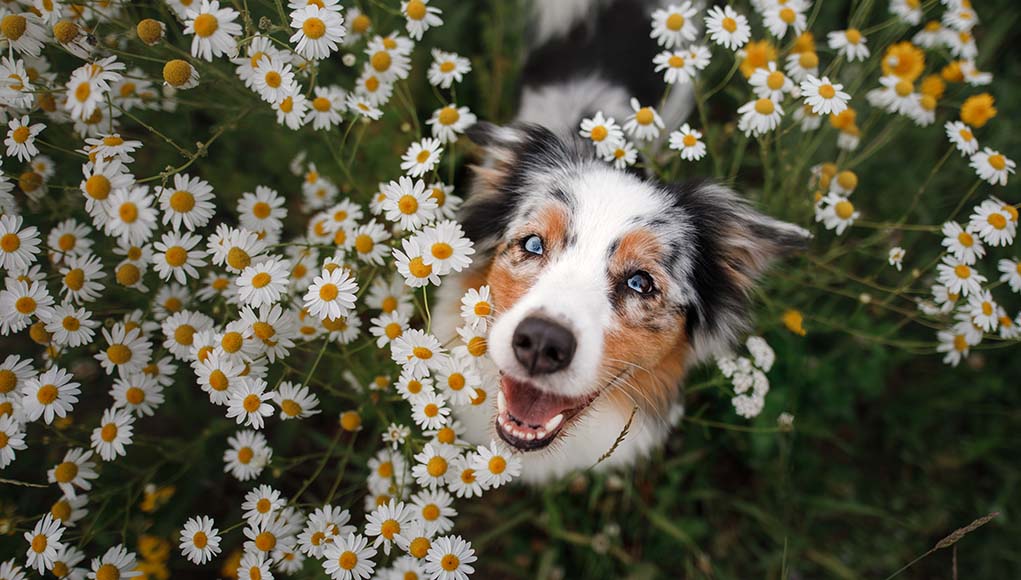Everything Is Blooming! Spring season is a time to watch for allergies and poisonous plants.
Allergies are one of the biggest problem and annoyance for most people in the spring. They are not just a human problem – dogs can very easily develop allergies too, and this can pose a problem both for your daily walks, as well as for the dog’s health in general.
Allergies occur when our immune system hyper-reacts to something that isn’t truly a threat. The immune system is our body’s day-to-day defense against anything that is unfamiliar. Most of the time, the immune system does an excellent job of keeping us and our pets healthy and preventing infection and disease. However, sometimes the body mount an exaggerated response to substances in the environment, termed allergens, that are typically viewed as harmless. That response can range anywhere from an annoyance to a life-threatening medical emergency.
The good news for pets is that the majority of allergic responses are dermatological. Dermatological reactions, otherwise known as skin-based allergies can manifest as itchy skin, skin infections, and ear infections. While these are not life-threatening, skin allergies can certainly be life-compromising and negatively impact your pet’s comfort, long term health, and quality of life when left untreated.
There is a misconception that allergic reactions to food are the mainstay of allergies in dogs and cats. While food allergies do exist, allergies to external parasites like fleas and environmental allergens like pollen, grasses, and dust mites are far more prevalent.
If you think that your pooch might have an allergic reaction, take them to the vet and get the dog tested to find out the cause. If there’s a problem, the vet will know what medications to prescribe. Don’t ignore any symptoms no matter how small. Some allergic reactions can start small and quickly develop into something much more significant.
It Time to Check your Garden Plans
The spring is a beautiful season full of gorgeously blooming flowers and plants, but a lot of them can present a danger for your dog. Whenever you are going out with your dog, make sure that he’s not eating any plants.
If you have a fondness for plants, learn those that are dangerous since it’s not practical to always be able to keep your dog away from all plants in general. As a side note, gardening equipment like fertilizers, pesticides and other chemicals should always be kept away from your dog too. Dogs are very attracted to fertilizer!
There are a huge number of plants that are highly toxic and even deadly to dogs. Some of these plants are present in your local park, nature areas, your neighbor’s garden, even your own home. While the list of toxic plants is very long, we’re going mention those that are commonly found around homes and neighborhoods.
Sago Palm: These ornamental palms are popular in warmer climates and every part of it is toxic to dogs. They are also said to be very alluring as some dogs find them quite delicious. Serious side effects including liver failure and possible death can occur, so be very careful.
Tomato Plant: With summer comes tomato plants in the garden. Make sure to keep dogs clear though, as they can cause weakness, gastrointestinal problems, drowsiness, dilated pupils, slow heart rate, and confusion.
Aloe Vera: We rub it on our skin and some of us even drink the juice, but aloe is something your dog needs to avoid. Saponins in this succulent can cause vomiting, diarrhea, lethargy, tremors, and general central nervous system depression.
Ivy: Vomiting, diarrhea, excessive salivation and drooling, and abdominal pain are caused by ingesting ivy.
Amaryllis: Another poisonous plant for dogs, this flowering bulb is a very common garden ornamental. Pay particular attention if you grow the bulbs indoors.
Gladiola: This lovely summer flower can cause drooling, vomiting, diarrhea, and general lethargy.
American-holly: A popular ornamental shrub in some areas, holly is a low toxicity plant but your dog may experience vomiting and diarrhea if they eat it.
Daffodil: Commonly found in the spring, these flowers can cause intestinal spasms, low blood pressure, salivation, tremors, vomiting, diarrhea, and even cardiac arrhythmia.
Baby’s Breath: You know it from virtually every bouquet of flowers you’ve ever received. This small flower that accompanies floral arrangements can cause vomiting and diarrhea.
Milkweed: Very common, very pleasant to look at, very toxic to dogs. Milkweed will induce the usual vomiting and diarrhea, but your dog may also experience difficulty breathing, rapid and weak pulse, dilated pupils, and even kidney or liver failure and death.
Castor Bean: Not common in gardens, castor bean is found in parks and other large-scale outdoor landscaping. If ingested your dog may experience drooling, vomiting, diarrhea, extreme thirst, loss of appetite, and abdominal pain. Potentially fatal in severe cases, which may present as muscle twitching, tremors, seizures, and even coma.
Azalea Rhododendron: These common flowering shrubs are poisonous plants for dogs and produce serious gastrointestinal issues. They can additionally cause weakness, discoordination, and weak heart rate. Potentially fatal.
Tulips: Who doesn’t love tulips? Hopefully Fido because they’re another poisonous plant for dogs. The usual gastrointestinal problems are accompanied by central nervous system depression and even convulsions and death.
Chrysanthemum: Vomiting, diarrhea, skin rash, and drooling may be in your dog’s future if they ingest this common flower.
Begonias: A very common garden flower that can cause extreme oral irritation and excessive inflammation of the mouth, as well as drooling and vomiting.
Oleander: All parts of this flower, fresh or dried, are poisonous and should be avoided by all pets.
These are 16 poisonous plants for dogs that you’ll need to look out for. If you have these planted in your garden or are using any of them to decorate the inside of your home, be especially careful and be sure your dog isn’t able to ingest them. If you notice a decline in your dog’s health and he is presenting with any of the symptoms listed above, contact your vet immediately or seek help with animal poison control at 888-426-4435.
For a more detailed list of Poisonous and Non-Poisonous plants list, please visit this site:
Toxic and Non-Toxic Plant List – Dogs | ASPCA








